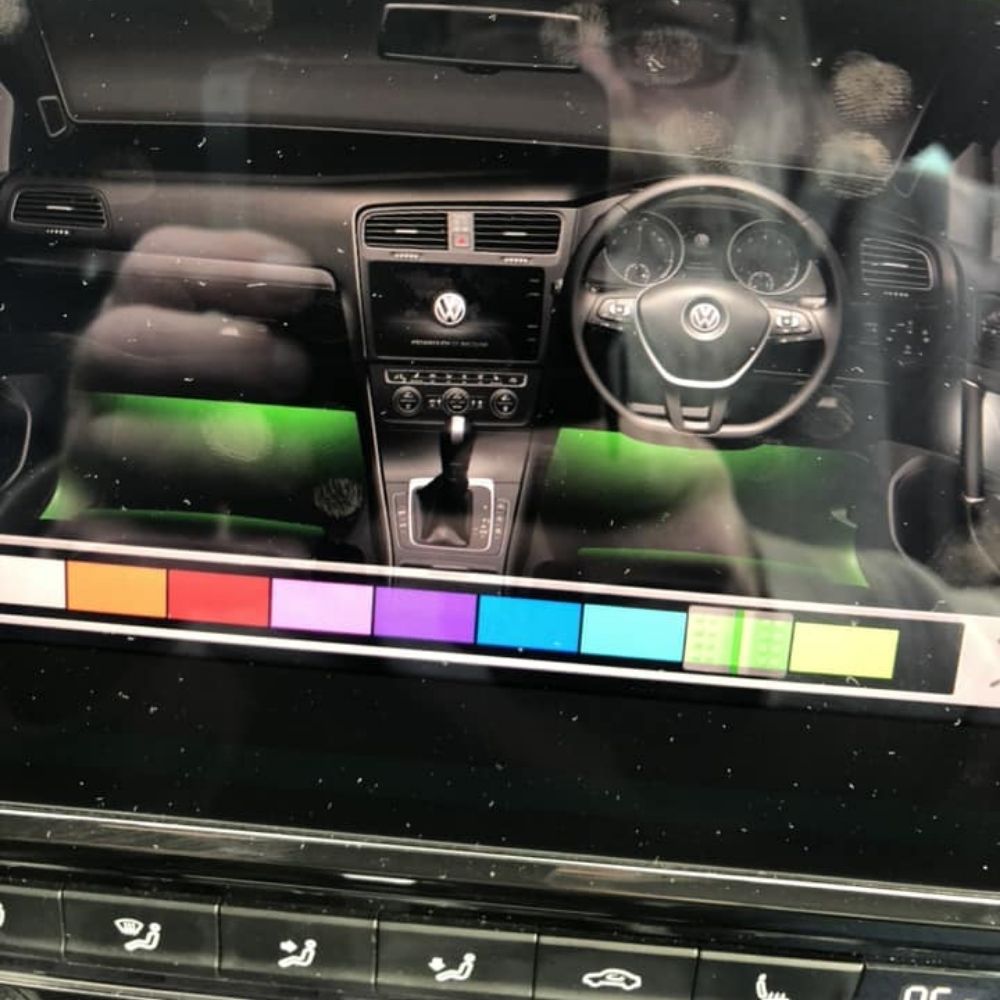
**What Does Audi DTC 02123 Indicate and How to Fix It?**
Contents
- Table of Contents
- 1. Understanding Audi DTC 02123
- 2. Common Symptoms of DTC 02123
- 3. Potential Causes of DTC 02123
- 4. Diagnosing Audi DTC 02123: A Step-by-Step Guide
- 5. Repairing Audi DTC 02123: Solutions and Procedures
- 6. Advanced Troubleshooting Tips for DTC 02123
- 7. Preventive Measures to Avoid DTC 02123
- 8. Using AutoExplain.com for Remote Diagnostics and Support
- 9. Related DTCs and Their Significance
- 10. FAQ: Frequently Asked Questions About DTC 02123
Dtc 02123 Audi, specifically referring to the “Door Warning Light / Entry Light: Electrical Fault in Circuit” error code, indicates an electrical issue within the door warning or entry light system of your Audi. This article provides a detailed breakdown of the causes, diagnostic steps, and repair solutions for this DTC, ensuring efficient troubleshooting and resolution. AutoExplain.com provides remote support and solutions that can help you resolve the issue efficiently.
Table of Contents
- Understanding Audi DTC 02123
- Common Symptoms of DTC 02123
- Potential Causes of DTC 02123
- Diagnosing Audi DTC 02123: A Step-by-Step Guide
- Repairing Audi DTC 02123: Solutions and Procedures
- Advanced Troubleshooting Tips for DTC 02123
- Preventive Measures to Avoid DTC 02123
- Using AutoExplain.com for Remote Diagnostics and Support
- Related DTCs and Their Significance
- FAQ: Frequently Asked Questions About DTC 02123
1. Understanding Audi DTC 02123
Audi Diagnostic Trouble Code (DTC) 02123 signifies an electrical fault within the circuit of the door warning light or entry light system. More specifically, it points to a potential issue with the electrical integrity of the door warning or entry light circuit. This fault can manifest as an open circuit, a short to ground, or a short to voltage, disrupting the normal operation of the door warning light. Proper diagnosis involves a systematic approach to pinpoint the exact cause of the electrical anomaly.
2. Common Symptoms of DTC 02123
What are the symptoms of Audi DTC 02123?
The most common symptoms associated with Audi DTC 02123 include:
- Malfunctioning Door Warning Light: The door warning light (also known as the entry light) on the affected door may not illuminate when the door is opened. The door warning light is designed to alert other drivers and pedestrians that the door is open, especially in low-light conditions.
- Entry Light Failure: The entry light, typically located at the bottom of the door panel, may fail to activate when the door is opened. Entry lights enhance visibility around the vehicle’s entrance area, providing added safety and convenience.
- Intermittent Operation: The warning light or entry light might function sporadically, working sometimes and failing at other times. Intermittent issues can be particularly challenging to diagnose, as the fault may not be present during initial inspection.
- Other Electrical Issues: In some cases, related electrical problems might surface, such as issues with the door lock, window operation, or other door-related electrical components. This can occur if the electrical fault affects multiple circuits within the door wiring harness.
3. Potential Causes of DTC 02123
What causes Audi DTC 02123?
Several factors can trigger the DTC 02123 in an Audi:
- Wiring Issues: Damaged, frayed, or corroded wiring within the door harness can lead to electrical faults. The constant opening and closing of the door can cause wear and tear on the wiring, leading to breaks, shorts, or insulation damage.
- Faulty Door Warning Light Assembly: The door warning light or entry light unit itself might be defective. A malfunctioning bulb, LED, or internal circuitry within the light assembly can trigger the DTC.
- Connector Problems: Corroded or loose connectors in the door wiring harness can disrupt the electrical connection to the door warning light. Connectors are particularly vulnerable to moisture and environmental contaminants, which can accelerate corrosion.
- Short Circuit: A short circuit in the door wiring can cause the door warning light to fail. Short circuits occur when a wire comes into contact with a ground or another voltage source, leading to excessive current flow and potential damage to the circuit.
- Grounding Issues: Poor or inadequate grounding of the door warning light circuit can result in the DTC 02123. A proper ground connection is essential for the circuit to function correctly, providing a stable reference point for voltage.
- BCM (Body Control Module) Fault: In rare instances, a faulty BCM can cause incorrect signals to be sent to the door warning light, triggering the DTC. The BCM controls various electrical functions throughout the vehicle, including lighting, door locks, and security systems.
4. Diagnosing Audi DTC 02123: A Step-by-Step Guide
How do I diagnose Audi DTC 02123?
Diagnosing Audi DTC 02123 requires a systematic approach to pinpoint the root cause of the electrical fault. Here’s a detailed step-by-step guide:
-
Initial Scan: Use a diagnostic scan tool like VCDS (VAG-COM Diagnostic System) or an equivalent OBD-II scanner to confirm the presence of DTC 02123 and check for any other related fault codes. This initial scan provides a comprehensive overview of the vehicle’s electronic systems and helps identify potential problem areas.
-
Visual Inspection:
- Wiring: Inspect the wiring harness in the door jamb and door panel for any signs of damage, such as cuts, frays, or exposed wires. Pay close attention to areas where the wiring flexes or bends when the door is opened and closed.
- Connectors: Check the connectors for corrosion, looseness, or damage. Disconnect and reconnect the connectors to ensure a good electrical connection. Apply dielectric grease to the connector pins to prevent corrosion and improve conductivity.
- Light Assembly: Examine the door warning light or entry light assembly for any visible signs of damage, such as cracks, broken lenses, or water intrusion.
-
Continuity Testing: Use a multimeter to perform continuity tests on the wiring between the door warning light and the BCM.
- Procedure: Disconnect the door warning light and the BCM. Set the multimeter to the continuity setting. Place one probe on one end of the wire, and the other probe on the opposite end. A good circuit will have low resistance and produce a beep from the multimeter.
- Expected Results: The wiring should have continuity, indicating an unbroken connection. If there is no continuity, there is a break in the wire that needs to be repaired.
-
Voltage Testing: Check for proper voltage at the door warning light connector using a multimeter.
- Procedure: With the door open and the ignition on, use a multimeter to check for voltage at the connector that plugs into the door warning light.
- Expected Results: You should see approximately 12 volts. If there is no voltage, there may be an issue with the power supply to the circuit.
-
Ground Testing: Ensure that the door warning light circuit has a good ground connection.
- Procedure: Use a multimeter to check the resistance between the ground wire at the door warning light connector and a known good ground point on the vehicle’s chassis.
- Expected Results: The resistance should be very low (close to 0 ohms), indicating a good ground connection. High resistance indicates a poor ground that needs to be addressed.
-
Component Testing: If the wiring and connections are good, test the door warning light or entry light assembly itself.
- Procedure: Use a multimeter to check the resistance of the light assembly. You can also apply voltage directly to the light assembly to see if it illuminates.
- Expected Results: The light assembly should have a specific resistance value (refer to the vehicle’s service manual for the correct value). If the light assembly does not illuminate when voltage is applied, it is likely defective and needs to be replaced.
-
BCM Testing: If all other components and wiring check out, the BCM might be the issue. This requires advanced diagnostic tools and expertise.
- Procedure: Use a diagnostic scan tool to communicate with the BCM and check for any internal fault codes or abnormal readings related to the door warning light circuit.
- Expected Results: The BCM should respond correctly to diagnostic commands and not display any fault codes related to the door warning light circuit. If the BCM is not communicating or is displaying fault codes, it may need to be reprogrammed or replaced.
-
Final Verification: After performing repairs, clear the DTC and re-scan the system to ensure the fault does not return. Operate the door and observe the door warning light to confirm that it is functioning correctly.
By systematically following these steps, technicians can accurately diagnose the cause of DTC 02123 and implement the appropriate repairs.
5. Repairing Audi DTC 02123: Solutions and Procedures
How do I fix Audi DTC 02123?
Once the cause of DTC 02123 has been diagnosed, follow these repair procedures to resolve the issue:
-
Wiring Repair:
- Procedure: If damaged wiring is found, repair or replace the affected sections. Use proper soldering techniques and heat-shrink tubing to ensure a secure and weatherproof connection.
- Best Practices: When repairing wiring, always use wire of the same gauge and type as the original wiring. Avoid using crimp connectors, as they can corrode over time and cause future problems.
-
Connector Replacement:
- Procedure: Replace any corroded or damaged connectors. Ensure the new connectors are properly seated and secured.
- Best Practices: Apply dielectric grease to the connector pins to prevent corrosion and improve conductivity. When replacing connectors, make sure to use the correct type of connector for the application.
-
Door Warning Light Assembly Replacement:
- Procedure: Replace the faulty door warning light or entry light assembly with a new unit. Ensure the new unit is compatible with the vehicle’s electrical system.
- Best Practices: When replacing the light assembly, check the wiring and connector for any signs of damage. Clean the area around the light assembly before installing the new unit.
-
Grounding Correction:
- Procedure: Clean and tighten any loose or corroded ground connections. Add additional ground wires if necessary to improve the grounding of the door warning light circuit.
- Best Practices: Use a wire brush or sandpaper to clean the ground connection points. Apply a corrosion-inhibiting compound to the ground connections to prevent future corrosion.
-
BCM Reprogramming or Replacement:
- Procedure: If the BCM is found to be faulty, it may need to be reprogrammed or replaced. This should be done by a qualified technician with access to the necessary programming equipment.
- Best Practices: When reprogramming or replacing the BCM, make sure to follow the manufacturer’s instructions carefully. Use the correct software and programming procedures for the vehicle.
-
Final Testing: After completing the repairs, clear the DTC and test the door warning light to ensure it is functioning correctly.
- Procedure: Use a diagnostic scan tool to clear the DTC. Open and close the door several times to verify that the door warning light illuminates correctly.
- Best Practices: Monitor the door warning light for any intermittent issues or unusual behavior. If the problem returns, re-check the wiring, connectors, and components to ensure that they are functioning correctly.
By following these repair procedures and best practices, technicians can effectively resolve DTC 02123 and restore the proper functioning of the door warning light system.
6. Advanced Troubleshooting Tips for DTC 02123
What are some advanced troubleshooting tips for Audi DTC 02123?
For complex cases of DTC 02123, consider these advanced troubleshooting tips:
- Check Door Jamb Wiring: Carefully inspect the wiring inside the door jamb, as this area is prone to wear and tear due to the constant opening and closing of the door. Use a flexible inspection mirror to get a better view of the wiring.
- Monitor Voltage Drop: Use a multimeter to monitor the voltage drop across the door warning light circuit while operating the door. Excessive voltage drop can indicate a problem with the wiring or connections.
- Use a Wiring Diagram: Refer to the vehicle’s wiring diagram to understand the layout of the door warning light circuit and identify potential problem areas. The wiring diagram will show the location of all the components and wiring in the circuit, as well as the color codes of the wires.
- Test with a Load: Use a test light or a resistor to apply a load to the door warning light circuit while testing. This can help reveal intermittent faults that may not be apparent under normal conditions.
- Consult Technical Service Bulletins (TSBs): Check for any TSBs related to DTC 02123 or door warning light issues. TSBs provide information about known problems and recommended solutions for specific vehicles.
- Use an Oscilloscope: Use an oscilloscope to analyze the voltage and current waveforms in the door warning light circuit. This can help identify subtle electrical problems that may not be detectable with a multimeter.
7. Preventive Measures to Avoid DTC 02123
How can I prevent Audi DTC 02123?
Preventive maintenance can significantly reduce the likelihood of DTC 02123:
- Regular Inspections: Periodically inspect the door wiring and connectors for any signs of damage or corrosion.
- Lubrication: Apply dielectric grease to connectors to prevent corrosion and ensure good electrical contact.
- Wiring Protection: Protect exposed wiring with split-loom tubing or electrical tape to prevent damage from abrasion or environmental factors.
- Gentle Door Handling: Avoid slamming the doors, as this can stress the wiring and connectors.
- Professional Servicing: Have the vehicle serviced by a qualified technician who can identify and address potential electrical issues before they become major problems.
8. Using AutoExplain.com for Remote Diagnostics and Support
How can AutoExplain.com help with Audi DTC 02123?
AutoExplain.com offers remote diagnostic and support services that can assist in troubleshooting and resolving DTC 02123. Our services include:
- Remote Diagnostics: Our expert technicians can remotely access your vehicle’s diagnostic system to perform advanced troubleshooting and identify the root cause of the problem.
- Step-by-Step Guidance: We provide detailed, step-by-step instructions to guide you through the diagnostic and repair process.
- Wiring Diagrams and Technical Information: We offer access to comprehensive wiring diagrams and technical information to help you understand the vehicle’s electrical system.
- Expert Support: Our team of experienced technicians is available via WhatsApp and email to answer your questions and provide expert guidance.
To get started, contact us via:
- WhatsApp: +1(936)2896695
- Email: [email protected]
Our team is ready to provide the support you need to resolve DTC 02123 quickly and effectively.
AutoExplain.com also provides on-site services at:
- Office Address: 1500 N Grant ST Sten Denver, CO 80203
- Website: AutoExplain.com
9. Related DTCs and Their Significance
What DTCs are related to Audi DTC 02123?
Understanding related DTCs can provide a broader perspective on potential issues. Some related DTCs include:
- 00912 – Window Regulator Switch Driver Side (E40): Indicates a problem with the driver-side window regulator switch.
- 00913 – Window Regulator Switch Passenger Side (E41): Indicates a problem with the passenger-side window regulator switch.
- 00914 – Window Regulator Switch Rear Left (E53): Indicates a problem with the rear left window regulator switch.
- 00915 – Window Regulator Switch Rear Right (E55): Indicates a problem with the rear right window regulator switch.
- 00916 – Door Lock Actuator Driver Side (F220): Indicates a problem with the driver-side door lock actuator.
- 00917 – Door Lock Actuator Passenger Side (F221): Indicates a problem with the passenger-side door lock actuator.
These related DTCs can provide valuable clues about the overall health of the vehicle’s electrical system and help identify potential problem areas.
10. FAQ: Frequently Asked Questions About DTC 02123
What are some frequently asked questions about Audi DTC 02123?
Q1: Can I fix DTC 02123 myself, or do I need a professional?
While some basic troubleshooting steps like inspecting wiring and connectors can be done by DIYers, diagnosing and repairing electrical faults often require professional expertise and equipment. AutoExplain.com can provide remote support to guide you through the process.
Q2: How much does it cost to fix DTC 02123?
The cost to fix DTC 02123 can vary depending on the cause of the problem. Simple repairs like wiring fixes might cost a few hundred dollars, while more complex issues like BCM replacement can cost significantly more.
Q3: Is it safe to drive with DTC 02123?
While DTC 02123 may not directly affect the vehicle’s drivability, it’s essential to address the issue promptly to ensure safety. A malfunctioning door warning light can pose a safety risk, especially in low-light conditions.
Q4: How do I clear DTC 02123 after fixing the problem?
Use a diagnostic scan tool to clear the DTC from the vehicle’s computer. If the problem has been resolved, the DTC should not return.
Q5: Can a dead battery cause DTC 02123?
A dead or weak battery can sometimes cause various electrical issues, but it’s unlikely to be the direct cause of DTC 02123. However, it’s always a good idea to ensure the battery is in good condition before troubleshooting electrical problems.
Q6: What tools do I need to diagnose DTC 02123?
To diagnose DTC 02123, you will need a diagnostic scan tool, a multimeter, wiring diagrams, and basic hand tools.
Q7: Where can I find wiring diagrams for my Audi?
Wiring diagrams can be found in the vehicle’s service manual or online databases. AutoExplain.com can also provide wiring diagrams as part of our remote support services.
Q8: How do I know if my BCM is faulty?
A faulty BCM can cause a variety of electrical problems, including issues with the door warning light circuit. If you suspect that the BCM is faulty, have it tested by a qualified technician.
Q9: Can aftermarket accessories cause DTC 02123?
Yes, improperly installed aftermarket accessories can cause electrical problems, including DTC 02123. Make sure that any aftermarket accessories are installed correctly and are compatible with the vehicle’s electrical system.
Q10: What should I do if I can’t fix DTC 02123 myself?
If you’re unable to fix DTC 02123 yourself, contact AutoExplain.com for remote diagnostic and support services. Our expert technicians can help you troubleshoot the problem and provide expert guidance to resolve the issue.


How to Coding Ambient Light for VW Golf R 2018 by OBDeleven

How to Perform 7 Speed DSG Basic Settings with ODIS on Skoda Octavia








